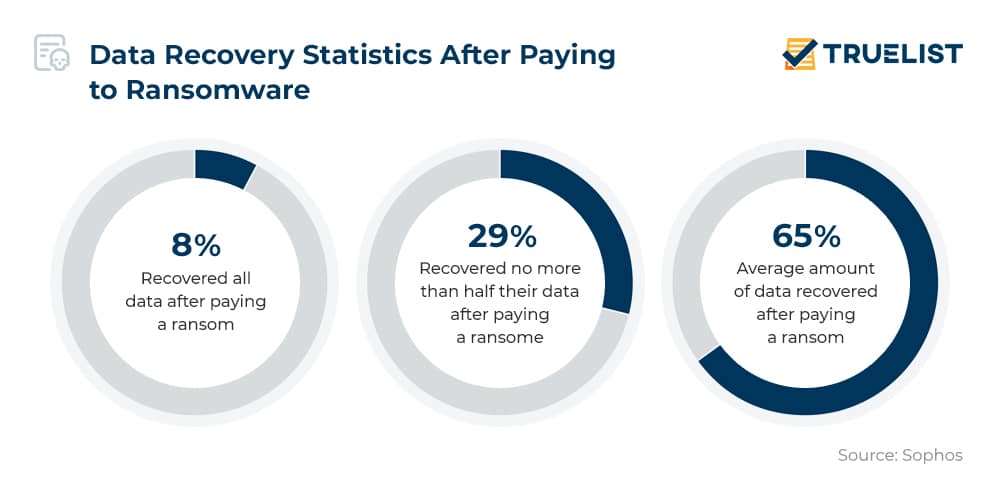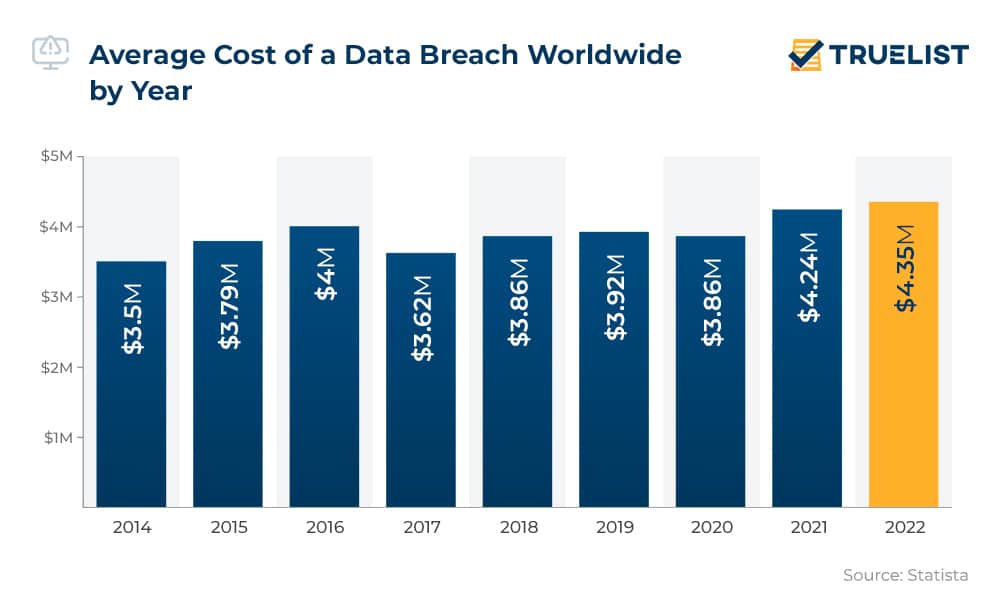We all know that data loss can happen to anyone, and it’s important to be prepared for the worst. But do you know how often data is actually lost? And what kind of data is most likely to be lost? These shocking data loss statistics will answer all these questions and more and will give you some tips on how to keep your data safe. Read on!
Data Loss Statistics (Editor’s Choice)
- Almost 70% of small businesses close within a year of a large data loss. (Consoltech)
- 33% of all folders in an average company are not protected at all. (Comparitech)
- The global average data breach cost in 2022 was $4.35 million. (Statista)
- 96% of workstations are not being backed up properly. (Uni Trends)
- 38% of IT professionals worry about mobility/BYOD policies at work. (Storage Craft)
General Statistics on Data Loss
1. Up to 94% of companies that experience a severe data loss never recover.
The impact of data loss could be so significant that it eventually sinks a business. This is partly because it can take around 280 days which is over nine months to identify and contain a data breach. The consequences can be pretty alarming:
- 51% of companies close within two years of the incident
- 43% do not reopen again
- Almost 70% of small businesses close within a year of a large data loss.
(Consoltech)
2. In 2021, 33% of folders were not protected at all.
Stats on data loss in a report by Varonis show that one-third of all folders used within a company is open to everyone, potentially exposing sensitive data and putting the organization at risk. In 2019, this percentage was only 22%.
(Comparitech)
3. The average ransomware victim loses 35% of their data.
Even if you pay the ransom demanded by cybercriminals, there’s no way to know for sure if you’ll get (all) your data back. As little as 8% of victims who pay ransom recover all of their data, data loss statistics show.
(Sophos)

4. The global average cost of a data breach in 2022 is $4.35 million.
This marks an increase from the $4.42 million for 2021. The expense depends largely upon which industry you’re looking at, with healthcare having by far the highest average price tag for these sorts of events.
(Statista)

5. 50% of all tape backups fail to restore.
Then, 77% of companies that test their tape backups find failures. In addition to that, workstations are not being backed up properly in 96% of cases, to begin with, data loss prevention statistics show.
(Uni Trends)
6. 42% of IT professionals think ransomware is the biggest threat.
When asked which technologies bring the most risk for data loss, IT professionals pointed to ransomware as their top concern. Many of them believe it’s more likely than any other form or event to cause them trouble with sensitive information like financial transactions and customer relationships. Some 38% feel worried about mobility/BYOD policies at work, while 9% are concerned over social media use for business purposes, causes of data loss statistics indicate.
(Arcserve)
7. Human error is among the top three causes of data loss.
Just over two-thirds (67%) of data loss is caused by hard drive crashes or system failure. Despite the much smaller percentage (14%), human error emerges as the number-two reason, followed by software failure with 10% to round out the top three data loss causes.
(Consoltech)
Data Loss Recovery Statistics
8. The average cost of data recovery from a broken hard drive stands between $100 and $2,000.
The cost of data recovery can be high and it’s important to find the right company for your needs. Some companies charge $1 per GB, which means a 3TB drive would cost you $3,000. The average cost of data recovery is usually contingent on the type of data loss and the severity of the damage. For example, a simple file deletion may only require a few minutes of work by a professional data recovery technician and may cost as little as $50.
However, data loss stats show that more serious losses such as physical damage to a hard drive or corruption of vital system files could take days or even weeks to repair.
(Proven Data Recovery)
9. It takes 3.2 hours to successfully recover 1TB HDD of around 90mbs.
Many factors affect recovery time, the drive’s size, whether it’s encrypted, etc. However, if the data loss is severe or the damage is irreparable, then professional data recovery companies may be the only option.
(Proven Data Recovery, 300 Dollar Data Recovery, Rossmann)
10. 39% of small businesses don’t have an incident response plan.
The devastating impact of data loss on a business is especially visible in small businesses. However, with proper planning and execution, data loss need not be the end of the world. Business data loss prevention statistics show that 93% of small companies have data or backups on the cloud. It is estimated that 59% were preparing for cloud-based recovery services in 2021.
(SSL Store, ESDS, Veritis)
11. The cost of a data breach averages $204 per employee for large organizations.
The cost of data loss can be significant. It can include the cost of recovery, lost productivity, and even legal penalties. In some cases, data loss can lead to the failure of a business. The price tag is even higher for small businesses, with cost of data loss statistics showing that they need $3,533 per employee to recover from such events.
(IBM)
In Conclusion
As technology advances, so does the potential for data loss. There are many ways to protect your data from loss, and most of them are easy and affordable. While it’s easy to feel discouraged by the thought of data loss, we can mitigate the risk of losing our valuable data by being proactive and using reliable backup solutions.
FAQs
What are the consequences of data loss?
Business data loss statistics point to significant consequences, starting with financial repercussions. Then comes reputational damage, as well as potential legal problems resulting from falling foul of data privacy regulations. Data loss can impact employee productivity, and as a result, hurt future revenue and profits.
(Security Boulevard)
How often do companies lose data?
While there are no exact data loss stats on that, studies show that 62% of people who own a computer have lost data at some point, while 76% have deleted something unintentionally. Naturally, this can happen in an organization as well, which makes backing data up essential.
(Backblaze)
How would you avoid data losses?
There are quite a few things you can do to avoid data losses, starting with an overall policy for your devices, including in relation to passwords. Then, you should back up all your data, and possibly, encrypt any sensitive information you operate with. Finally, data loss statistics show that you should update your equipment regularly, and ideally, use antimalware programs such as email security software.
(DataSpan)
Sources: Consoltech, Comparitech, Sophos, Statista, Uni Trends, Arcserve, Proven Data Recovery, 300, Dollar Data Recovery, Rossmann, SSL Store, ESDS, Veritis

